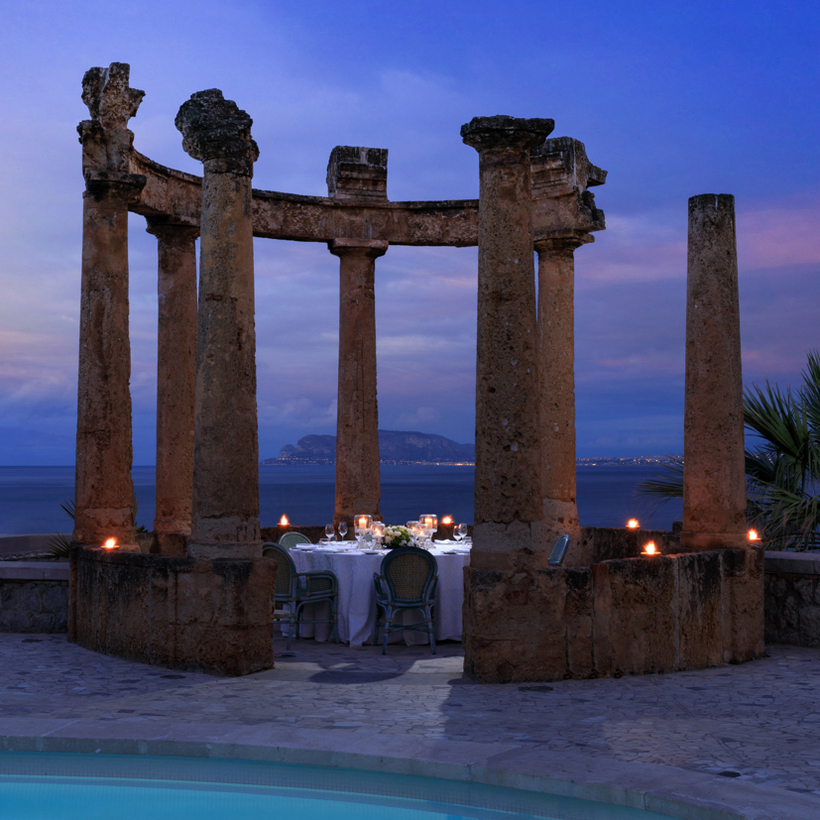Above the bay of the Conca d’Oro, on the elegant, pilastered terraces of Villa Igiea, sunset is a ritual benediction, attended by Palermo society and guests of the hotel. The sun, a Communion wafer, dips into the wine-dark sea.
Dusk draws intense scent notes from the cypresses while a soprano sings a Donizetti hymn at the bar. In the nighttime spotlight, the silhouette of the Greco-Roman temple lengthens, and the Villa Igiea becomes a theater, animated by the choreographed flow of waiters. Stage left, an international wedding party applauds the rock-star chef, Fulvio Pierangelini, as he bows his shaggy head to crack open the baked salt crust of the branzino. The release of herb-scented steam from the noble fish is like the first act.

In the “orchestra seats,” the Palermo chorus of jewel-encrusted denizens and duchesses of the crumbling city palazzi gossip in loud stage whispers. As regulars, they have come to approve the $35 million restoration of the Art Nouveau palace by Rocco Forte and his sister, Olga Polizzi.
For this is more than just a favorite cocktail haunt, the landmark and symbol of their city’s Liberty-era heyday. It also represents a cherished and disappearing way of life. A waiter slides by with a subtly placed ashtray to catch their butts. High walls seal off the garden estate from suburban sprawl, but on the horizon a handful of “bunga bunga” pleasure cruises zip alongside the marina to the anchorages off Scopello.

Coming to Sicily brings you back to life. So that’s a yes to that refill of Grillo, the regional white wine, as bone dry and mineral rich as the soil on which it thrives. And yes to a Villa Igiea cannoli special, the traditional, deep-fried pastry tube that oozes sweetened ricotta and candied orange peel.
My husband raises an eyebrow at the calorific and overtly phallic desert. “Leave the gun, take the cannoli,” he says, in his best Godfather voice, watching me tuck in. “I can see that living well certainly is your best revenge.”

The next day, I buy more of the trademark cannoli and the Breasts of the Virgin, custardy cakes topped with a cherry. They are a specialty of the Santa Caterina nunnery, the recently reopened 14th-century cloisters and bakery.
“I can see that living well certainly is your best revenge.”
Food, sex, money, death: Was it the English writer D. H. Lawrence who nailed Sicilian culture so succinctly? Palermo’s unofficial decorative emblem, the Testa di Moro (the Moor’s head), is, after all, a decapitation disguised as a plant holder. The medieval Arab conquest lasted around 75 years, and today the traditional pots embellish the corridors and bedrooms of the Villa Igiea’s otherwise sober and intelligent restoration, which allows the grandeur of Ernesto Basile’s architecture to shine through.

It’s a turreted palace of many windows—the window is as important a symbol in the Italian psyche as the hearth is in an English home. One of the most life-affirming images of the pandemic era was the sight of an Italian at a window, singing to the street.

An hour’s drive away is Cefalù, and away from the main tourist drag around the celebrated Byzantine cathedral, life is played out from the balconies and open windows. The latest football scores are announced across the street; kids hoist groceries from sidewalk to eaves with rope pulleys and baskets.
Cefalù Beach isn’t just for the tourists. In Sicily, the beach is the great equalizer, the most democratic of arenas; it’s for grandparents on deck chairs sitting fully clothed beside underdressed, tattooed couples and babes in carriages. There, the whole of humanity is all over each other, like “melted butter over parsnips,” as D. H. Lawrence also observed.

I shook salt into fried whitefish, nestled in a paper twist of yesterday’s news. A friendly pensioner had given this stall the thumbs-up, and, indeed, it was a taste sensation as memorable as Villa Igiea’s ceremonial sea-bass feast. “Thank you for coming to Sicily,” the pensioner says graciously, gesturing at the table, the beach, the historic coastal city, as if welcoming us into his own front room.
Catherine Fairweather is a travel writer for The Guardian, the Financial Times, British Vogue, and others. She is based in England’s West Country


